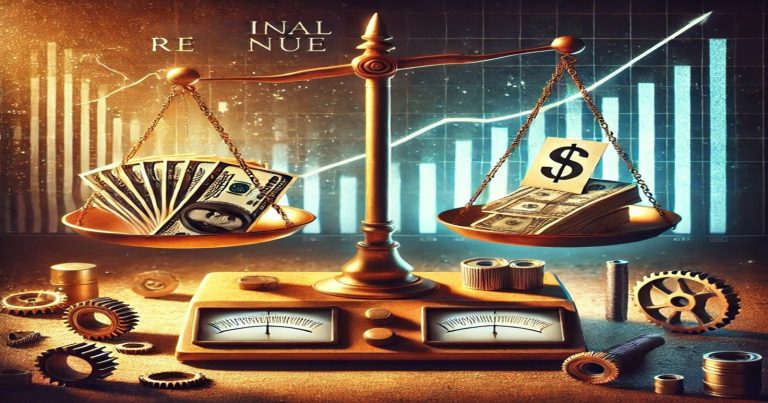Marginal revenue is the revenue earned by an additional sale. This is one of the factors that influence pricing and output decisions. A grasp of marginal revenue becomes essential for pricing decisions and profit-maximising and economic choices. Marginal revenue is computed as the change in total revenue per change in the quantity of the goods sold. It is a central concept in the field of microeconomics. This is important in the two giants of the market: monopoly and perfect competition. No, we shall elaborate on it.
What is Marginal Revenue?
Marginal revenue is the income a firm incurs to sell one more unit of output. It influences businesses’ pricing decisions and helps firms decide about their optimal production level. One would surely be able to fully understand marginal revenue only if one knew its formula, its examples, and how they relate graphically.
Definition of Marginal Revenue
Marginal revenue is the increase in total revenue when the firm sells one more unit of a good or service. It is one of the more critical concepts in economics since it helps firms identify the level of production that is most profitable.
Marginal Revenue Formula
The formula for marginal revenue works like this:
Where:
MR = Marginal revenue
ΔTR = Change in total revenue
ΔQ = Change in quantity sold
Marginal Revenue Example
If a firm sells 10 units at $100 each and 11 units at $108 each, marginal revenue from the 11th unit is:
If it sells one more pair, the firm receives an additional $20 in revenue.
An example would be a shoe company selling 100 pairs for $50 each, making a profit of $5,000. So if you make $5,020 selling 101 pairs, then:
The firm gains $20 in additional revenue by selling one more pair.
Marginal Revenue Curve & Graph
The marginal revenue curve shows how much more money is made per change in output. In pure competition MC is a straight horizontal line because the price remains constant for the firms. But it has a downward-slopping curve under monopoly indicating that sales at decreasing prices must be lifted to achieve more revenue.
Marginal Revenue vs. Marginal Cost
Understanding how the two will help both make business decisions about producing profitably. These two have a relationship measured by different levels of output within. Marginal Revenue versus Marginal Cost
- Marginal revenue (MR) is any income from selling one more unit.
- Marginal cost (MC) is an extra cost when producing one additional unit.
A business will make maximum profit when MR = MC. If MR > MC, production increases profit; if MR < MC, losses are avoided by cutting back on production.
In these terms, the Economics of Marginal Revenues and Costs, In microeconomics, firms want to attain the equilibrium point where MR = MC to maximise profits. If they produce beyond this level, when MC is less than MR, their costs will exceed revenues, resulting in a loss. Firms should understand the extent of marginal inference to stay profitable.
Marginal Revenue Formula or Equation
The marginal revenue function shows how revenues change with output. If total revenue (TR) is:
Then, the marginal revenue equation is the derivative of TR concerning Q:
The above statement describes the importance of price and quantity optimisation in organisations. This marginal revenue depends on the elasticity of demand. A price cut brings higher overall receipts if demand is elastic. When it is inelastic, a price drop reduces revenue. In understanding marginal revenue from demand, companies devise suitable pricing on their goods to maximise profit.
Marginal Revenue in Monopoly
Competition is much better compared to monopolies since they are price makers. The peculiar feature of a monopoly is that the shape of its marginal revenue differs simply because the monopolist is supposed to have a demand curve inclined downwards.
Marginal Revenue Curve in Monopoly
Marginal revenue lies below the respective demand curve in a monopoly since an increase in output from an assumed 1 unit would require a price reduction for the total products sold, thus lowering marginal revenue.
Marginal Revenue Calculator for Monopoly Companies
A marginal revenue calculator refers to any monopolist who determines an amount through various pricing strategies because he must adjust quantity and prices for the monopolist to get the maximum profit from total revenue.
Marginal Revenue Product
Marginal revenue applies beyond goods, for it also applies to labour. One helpful measure in this regard is the marginal revenue product (MRP), which refers to the additional revenue that would result from hiring one more worker. Marginal Revenue Product of Labor
The MRP is calculated as:
Where MP is marginal productivity, and MR is marginal revenue. Firms hire workers until MRP = wage rate.
Relevance to ACCA Syllabus
One of the key terms in ACCA syllabus specially operational and financial management paper. Similar to this, this allows the accountants and finance professionals to better understand the costs involved in generating revenue and optimise the profits. Marginal revenue is particularly essential when making decisions about pricing, as well as budgeting and determining whether projects are financially feasible, which are important areas of managerial and financial decision-making in ACCA exams.
Marginal Revenue ACCA Questions
Q1: What is marginal revenue?
A) Gross revenue of a company
B) The marginal revenue from the sale of the last unit of a good
D) Total revenue and total costs
D) The remaining profit after all costs have been subtracted
Ans: B) Denotes the additional income derived from selling one additional unit of a product
Q2: What should a company do if marginal revenue is less than marginal cost?
A) Increase production
B) Decrease production
C) Produce at the same level
D) Reduce prices
Ans: B) Decrease production
Q3: In a perfect competitive firm, what is the relationship of marginal revenue with price?
A) Price is less important than marginal revenue
B) Here, marginal revenue is lower than price
C) Marginal revenue = price
D)Marginal revenue has no relation of price
Ans: C) Marginal revenue = price
Q4. Which of the following is TRUE in terms of marginal revenue?
A. It never changes with respect to output
B) It is obtained from the total revenue curve
C) The difference between total cost and total revenue
D) It is never above the average revenue.
Ans: B) It is derived from the total revenue curve
Q5: As a firm increases the quantity it sells, its marginal revenue gets smaller. What does this indicate?
A) The firm is a price-taker
B) The firm’s product is in lesser demand
C) The firm is operating in a monopoly market
D)There is a fixed pace at which the firms total revenue is rising
Ans: (B) Less demand for products of firm
Relevance to US CMA Syllabus
Marginal revenue is a core topic of the cost and management accountants CMA syllabus in various subjects such as decision analysis, pricing strategy, and performance management, among others. Once again, CVP analysis is highly relevant in CMA exams, and as a business decision the best way to formulate the decision is through CVP analysis, which means a case study similar to the ones earlier can be the study material you should spend time training with.
Marginal Revenue CMA Questions
Q1: What is marginal revenue and how do we calculate it?
A) dTR/dQ
B) TR/TQ
C) total revenue minus total cost
D) Rents ratio over quantity
Ans: A) Change in revenue over change in quantity sold
Q2: Which pricing strategy as described in this blog, is factored into the decision process of marginal revenue?
A) Full-cost pricing
B) Cost-plus pricing
C) Marginal-cost pricing
D) Competitive pricing
Ans: C) Marginal-cost pricing
Q3: A company is producing at a point where marginal cost equals marginal revenue. What does it have to do to make a profit?
A) Increase output
B) Decrease output
C) Maintain establishment level output
D) Lower the price to sell more
Ans : C) Maintain the same level of output
Q4: When is marginal revenue most useful in decision-making?
A) Long-run investment decisions
B) Short run pricing and production decisions
C) Regulation compliance decisions
D) Dividend distribution decisions
Ans: B) Pricing and production decisions in the short run
Q5: Is the firm under monopolistic competition: How is its marginal revenue?
A) P = MR
B) D as marginal revenue is always more than price
C) Marginal Revenue marginal cost Produce more if marginal revenue marginal cost, make more
D) Making financial decisions without considering marginal revenue
Ans: C) Marginal Revenue marginal cost Produce more if marginal revenue marginal cost, make more
Relevance to CFA Syllabus
CFA: Marginal revenue plays a highly relevant role in CFA, where it is applied in the studies of financial analysis, corporate finance, and investment decisions. In the context of equity valuation, portfolio management and financial modelling which forms the part of CFA exams, marinal revenue helps assess the profitability of the company along with pricing strategy and revenue forecasting.
Marginal Revenue CFA Questions
Q1: Why is a firm’s Marginal Revenue relevant to a firm’s stock valuation?
A) It has no impact on stock valuation
B) Higher marginal revenue means more future earnings, stock value
C) Always increases stock price with lower marginal revenue
D) Marginal revenue is specific to private companies.
Ans: B) Higher marginal revenue means more future earnings, stock value
Q2: As it pertains to financial modeling, marginal revenue is typically used to estimate:
A) Tax liabilities
B) Operating cash flows
C) Dividend payout ratios
D) Net asset value
Ans: B) Operating cash flows
Q3: A firms marginal revenue curve is steeper than its demand curve. What does this suggest?
A) Firm has a whole lot of pricing power
B) This is the firm in a perfect competition.
C) The company cannot choose its own prices
D) Marginal revenue always equals demand curves
Ans: B) The firm has an excellent moaty pricing power
Q4: When making these types of investment decisions, what is a finance term that is closely related to marginal revenue?
A) Price to earnings (P/E) ratio
B) Return on assets (ROA)
C) EBIT (Earnings before interest and taxes)
D) Gross margin
Ans: C) EBIT (Earnings before interest & taxes)
Q5: What do we care about marginal revenue in M&A?
A) It approximates the revenue impacts of the merging firms
B) Used to figure the taxes owed
C) It evaluates the productivity of employees
D) It is not anything to do with M&A decisions
Ans: A) This is helps to understand the financial impact of merging firms
Relevance to US CPA Syllabus
Understanding marginal revenue is a crucial topic of the CPA syllabus, specifically in cost accounting and financial analysis. It helps CPAs make pricing choices, revenue projections, and the financial impact of production quantities. To prepare financial statements, perform variance analysis and aid in strategic financial decision-making.
Marginal Revenue CPA questions.
Q1: Which of the following statement is correct regarding relationship between marginal revenue and elasticity of demand?
A) Demand is Elastic when Marginal Revenue is Negative
B) When demand is inelastic, marginal revenue is positive
The correct option A — Marginal revenue is positive when demand is elastic.
D) Marginal revenue is independent of demand elasticity
Ans: C) Demand is elastic when marginal revenue is positive.
Q2: CPA will use marginal revenue in decision making in financial statement?
A) Balance Sheet
B) Income Statement
C) Statement of Cash Flows
D) Statement of Changes in Owners Equity
Ans: B) Income Statement
Q3: A firm reduces its selling price, resulting in negative marginal income. What does this indicate?
A) The firm operates in a perfectly competitive market
B ) Increasing returns to scale apply to the firm.
C) The firm undercut prices even further, decreasing total revenue
D) The firm generates above normal profits.
Ans: C) The firm has over lowered prices and total revenue decreased
Q4: What business strategies would a CPA recommend using marginal revenue analysis?
A) If marginal revenue MC, reduce output
C) If marginal revenue>marginal cost, then produce more
D) Making financial decisions without accounting for marginal revenue
Ans: C) A firm would expand output when marginal revenue > marginal cost
Q5: The marginal revenue curve of a firm is downward sloping. In what market structure do you think most likely it is working?
A) Perfect competition
B) Monopoly
C) Oligopoly
D) Monopolistic competition
Ans: B) Monopoly


